Just Talkin’ About Francis…
BLU-RAY STREET DATE: MAY 3, 2022/KL STUDIO CLASSICS
DIRECTED BY ARTHUR LUBIN (Films 1-6); CHARLES LAMONT (Film 7)/KL STUDIO CLASSICS
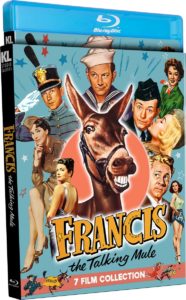
Once upon a time, there was a mule that could talk. His name was Francis, and he became one of the most popular Hollywood movie stars of the 1950s. Between 1950 and 1956, Francis (actually portrayed by a female mule called Molly, for modesty’s sake) was the name-in-the-title draw in seven feature film comedies for the rapidly changing studio, Universal International.
Francis had a great many fans, but fandom didn’t dominate the way that it does nowadays. It was a time before such popcorn movies were picked apart for “Easter eggs” and expected to tease future installments with obtuse post-credit scenes. Audiences were happily content to revisit a franchise year after year without demanding explanations of the fantastic elements (why can the mule talk, anyway?), expecting secret origins, or debating just how Francis the Talking Mule fits into the MCU. What could be counted on was Francis helping his affably repressed human buddy, Pete Stirling through all manner of scrapes and mix-ups. (Pete is portrayed by an increasingly game Donald O’Conner in the first six of the seven films; Francis is distinctly voiced by Western actor Chill Wills for the same duration).
If this franchise had a Kevin Feige, it must’ve been Arthur Lubin, a Universal Studios veteran of Abbott & Costello comedies. Lubin helmed the first film (based on a 1946 novel by David Stern, who was a U.S. Army Captain), and would go on to direct the next five Francis sequels. If there’s someone behind the scenes who creatively managed this big-screen glue factory, it was undoubtably Lubin. Under his watch, the series maintained its own distinct grounded-yet-goofy reality, featuring numerous great co-starts along the way (including Julia Adams, Mamie Van Doren, ZaSu Pitts, David Jannsen, Clint Eastwood, and… another Donald O’Conner??).
Though not critical hits, the film series did far too well for the plug to be pulled any sooner than film seven. (Notably, the final one, Francis in the Haunted House, sees all key talent swapped out). For the occasion of this three-disc, seven-film set (two films on the first two discs; three on the third), Kino Lorber has utilized brand new 2K masters for each movie, and each with a newly recorded optional commentary track by various film historians that are into this sort of thing. It’s as much as any mule could ask for!
*****
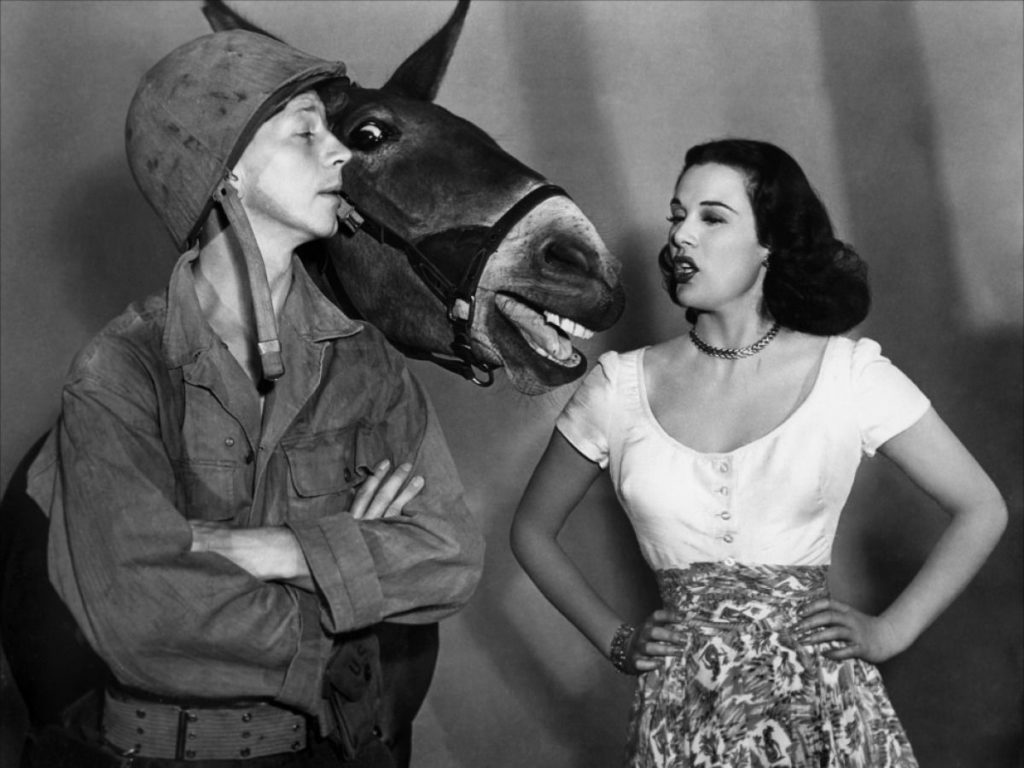
First up is 1950’s plainly-titled Francis. It’s a weirdly lopsided kind of movie insofar as this wacky-sounding picture about a mule that can talk is actually a World War II film with a shockingly high bodycount. U.S. Army Second Lieutenant Pete Stirling (Donald O’Conner) is taken for a mental case by his superiors when he reports of the titular talking mule that he meets in the jungles of Burma. The mule, ever the patriot, is keen to pass along all the sensitive Japanese intel that he hears while ambling about the brush.
But wouldn’t you know it, the darn animal is stubborn? This means he won’t speak in the presence of anyone else. The girl of the movie, Patricia Medina, wants to believe him. The General (John McIntire) most certainly doesn’t. Will Francis finally speak up in order to get Pete out of ZaSu Pitts’ basket-weaving mental ward?
In any case, the stakes in this story are weirdly high for a movie that became a children’s classic of its time. Indeed, Francis plays like a studio wartime propaganda film made five years too late. The casualty count of enemy “Japs” that Pete and Francis work together to ambush is shockingly high- and O’Conner’s grin couldn’t be bigger. It’s not a spoiler to say that both Francis and Pete survive this wartime tale, seeing as how they go on to co-star in a lot more movies in this soon-to-be series.

Things have changed at the outset of the immediate follow-up, 1951’s Francis Goes to the Races. With the war over, Pete and Francis have taken up residence in good ol’ Kentucky. But wouldn’tcha know it, Pete’s friendship with the animal is threatened when they fall in with the cutthroat professional horse racing circuit. Pete, now a veterinarian, spends the film bumbling his way through trying to help a wealthy family that’s forced to give up their priced steed. Francis, though, gets the inside scoop on future race results from his four-legged stable mates. A few bets at the $2 window for Pete won’t hurt anyone… that is, until the bad guys catch wind of his winning streak.
Francis Goes to the Races is a marginally better movie than the first one, but it’s still no Shot in the Dark. In this film, Chill Wills brings a more distinctively Cajun flair to Francis’ voice this time, which is interesting but doesn’t last. Also, it’s hard not to hear what is almost certainly implications of amorous antics in the mule’s descriptions of what he’s been up to in his new job. Why, Francis…! It should also be mentioned that although Goes to the Races has 100% less death and war than its predecessor, the ending situations are virtually the same.
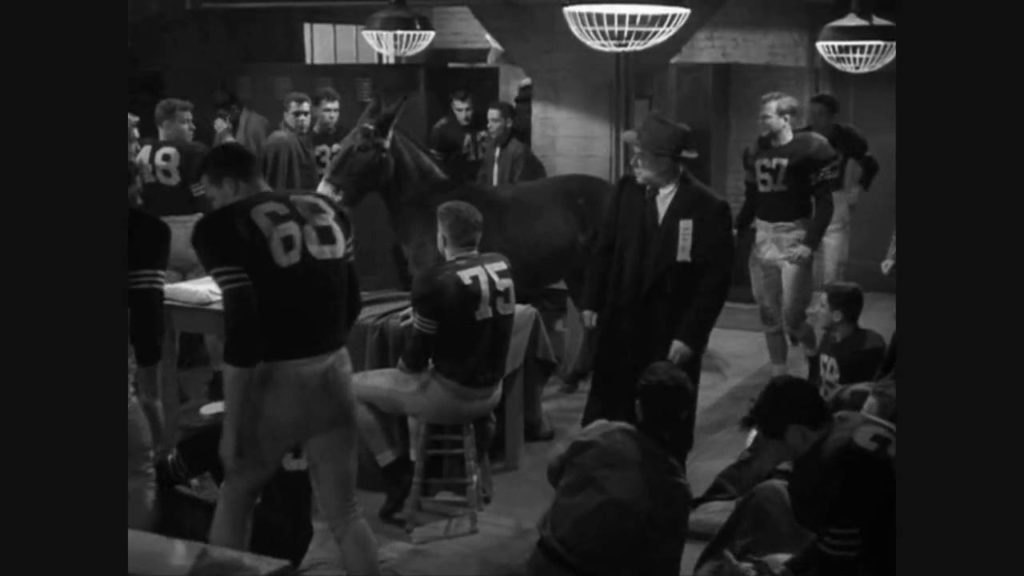
Things get marginally more complicated with 1952’s Francis Goes to West Point. When Francis tips off Pete about an explosive sabotage plot at the atomic energy plant he’s now employed, the authorities are so grateful that they usher Pete into that gleaming military academy on a hill, West Point. Francis follows, revealing himself to be quite the book-smart animal as he surreptitiously helps out his old pal.
Pete gets off to a promising start, striking up new friendships but also incurring the strict ire of low-level officers played by James Best and David Jannsen. Francis continues to exert his influence on the film’s big football game as the coach and the whole team get chatted up. At this point, if social media had existed, Francis’ secret would’ve gone viral within ten seconds of the huddle. Pete, meanwhile, has a secret of his own. Well, not really, but he’s too good of a fella not to take the fall for a fellow cadet, allowing the powers that be to think he’s married with a kid on the way- quite a leap for the obviously sexually naive Pete. (Francis: “He has about as much firsthand experience in that area as I do!”). More of a nice morality tale than an outright comedy, Francis Goes to West Point is again marginally better than its predecessor.
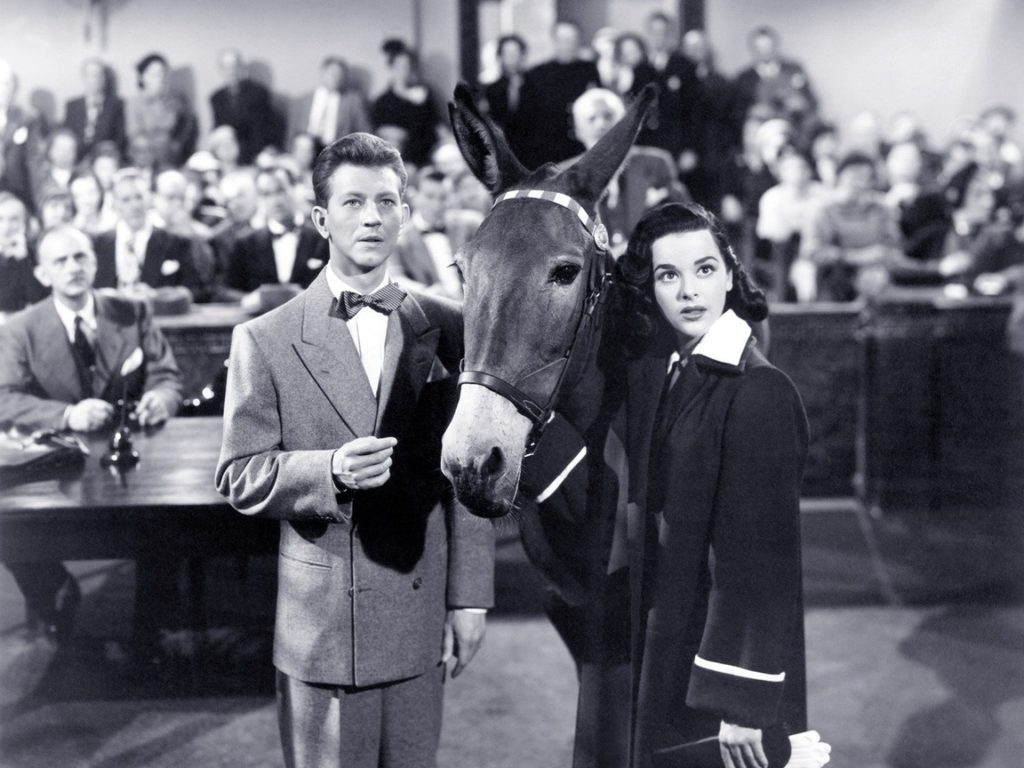
Filmed concurrently with West Point was Francis Covers the Big Town (1953). The events of the previous picture go completely unreferenced, including the ending where Pete (O’Conner) and Francis seem to go their separate ways until they meet again. Apparently, they met again pretty quickly, and Pete has seemingly put West Point completely behind him, despite landing on his feet rather well there. Nope, enough of that. Now, it’s off to the Big Apple in search of life’s next great adventure!
For this film, Universal actually spent some money and sent O’Conner and Francis and his handlers to New York City for some authentic “big city” street shots. This gives Big Town a more satisfying scope than the previous three studio-bound entries. Also adding to its appeal is that it’s a newspaper picture, complete with a busy city room, a non-nonsense editor (Gene Lockhart), a hard-bitten reporter, and a Lois Lane type (Nancy Guild) who’s perhaps a bit too opportunistic.
Pete wanders into this as a copy boy all too eager to make the jump to beat reporter. His naïveté is meant to be charming in a Jimmy Olsen kind of way, and O’Conner certainly pulls it off. All the better to contrast when Pete does make the professional jump he was hoping for and gets a bit too big for his britches. Don’t worry, Francis will take him down a few pegs. All Pete’s success is of course owed to Francis, who gets all the vital scoops on which criminals are planning which crimes from local horses and whatnot. But that’s not all- Francis also instructs Pete’s proper love interest (Yvette Dugay) in the fashion of seduction in an attempt to turn his foolish eyes away from Nancy Guild’s troublesome character. It’s kind of initially cringey, but Dugay does come out on the other side looking rather cute. As for Francis, he becomes smitten with a local caged zebra. In the mix is plenty of newspaper talk, uncovered corruption, and even some gunplay.
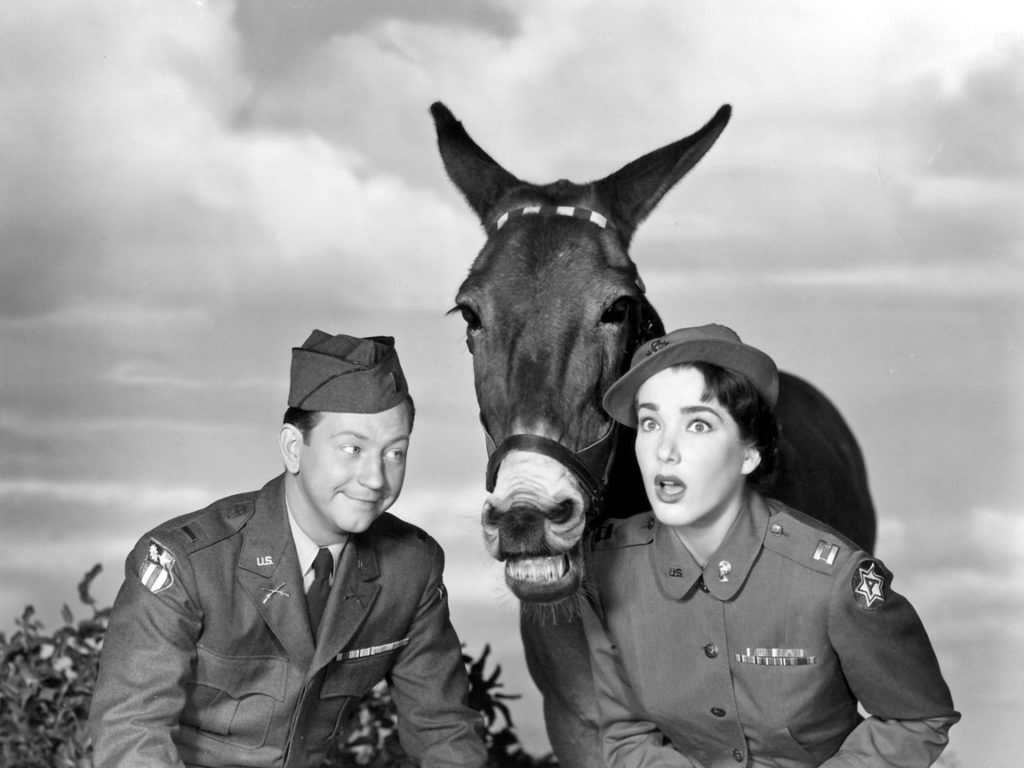
Then there’s 1954’s Francis Joins the WACS, noteworthy for demonstrating far before Fast Five that sometimes Universal Studios simply needs to get to the fifth movie for a series to finally find its footing. WACS finds Pete mistakenly recalled into the military, making this a kind of pronounced and more direct sequel to the first film. They talk about Burma an awful lot, and the same scatterbrained mental ward nurse played by ZaSu Pitts returns for a few laughs.
WACS is also the first Francis movie that is distinctly post-“Make ‘Em Laugh”, which must’ve tipped Arthur Lubin and company off about the talent in Donald O’Conner that they’ve been failing to fully utilize. Consequently, O’Conner is given far more physical clowning and rapid comedic takes than ever before when playing Pete. This paired with the best basic premise yet for one of these pictures (Pete is drafted alright… into the Women’s Army Corps! Naturally, Francis follows), plus the series’ best supporting cast make this one a surprise keeper. Just have a gander at this lineup: Julia Adams! Mamie Van Doren! ZaSu Pitts! And Chill Wills… as General Benjamin Kaye?? Yes, it’s true- at long last, the unmistakable voice of Francis shares scenes with Francis! It’s potential comedy gold that’s been a longtime coming, and it pans out from the moment the real Wills is revealed.
Mild but still suggestive banter (talk of the misplaced Pete being “re-assigned” makes him particularly nervous) and racy situations (Pete is unable to tell the difference between a woman soldier at attention or at ease because of, you know, boobs) push the envelope ever so slightly for the heretofore squeaky-clean series. Also notably, for several of the cast, WACS was not an easy shoot. Julia Adams gets a big piece of luggage dropped on her and is then accidentally doused by a trainyard water tower. That’s some treatment to endure in the service of the fifth film in this particular series, which no contract player was hot to trot about appearing in. But not to be outdone, O’Conner contracted a virus from the mule. Considering that he already had one foot out the door of this franchise, this illness, said to cause him to pass on being in the high-profile White Christmas, was a last straw.
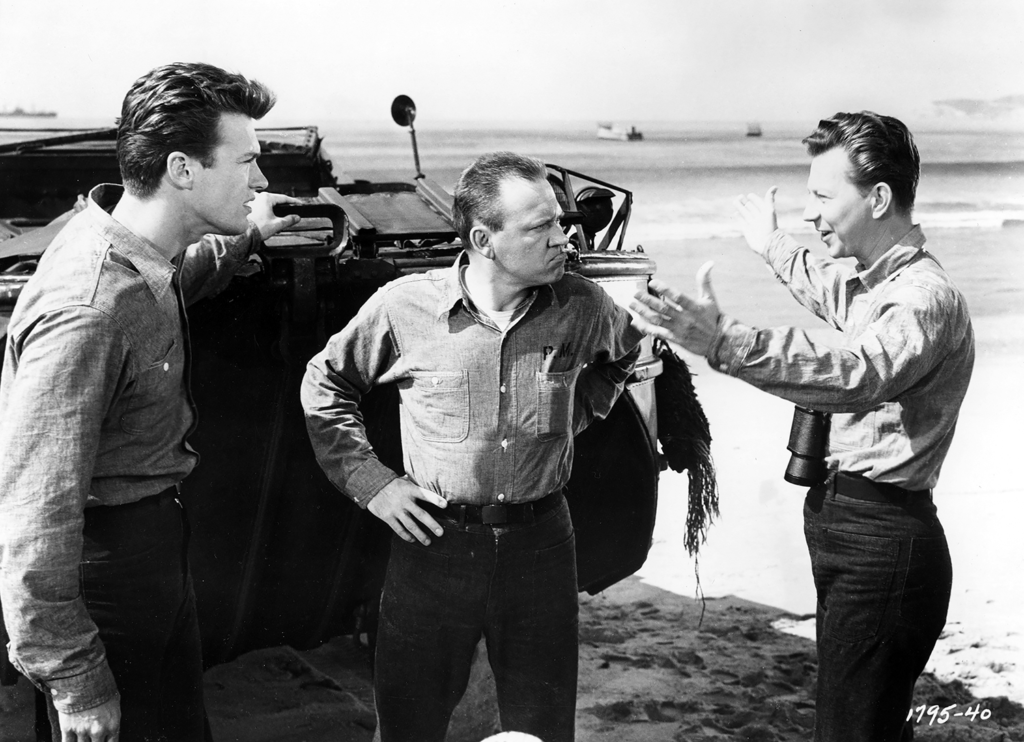
Well, maybe not quite the last straw. Maybe one more… Someone at Universal must’ve noticed that Pete hadn’t yet served in all the branches of the armed services. So, to further along that pointless goal, along comes the sixth film in the series, Francis in the Navy (1955). Pete, though, being an Army guy, runs into the old traditional Army/Navy feud. More specifically, he runs into himself. That’s right, an exact Pete Stirling doppelgänger, named ‘Slicker’ Donevan has been kicking around the Naval base, and wouldn’t you know it, he’s a troublemaker! He’s not quite a Buddy Love to Pete’s Professor Kelp, but it’s close. Lots of people are on the lookout for Slicker, resulting in Stirling repeatedly being mistaken for him. That results in him being forcibly stripped of his uniform, down to his boxers, over and over. How humiliatin’. For sure, viewers who observe that the Francis series is wholly about some combination of post-traumatic stress and even mental illness will find plenty to latch onto here.
It’s been said that everyone under contract at Universal was eventually made to appear in a Francis film. This time, young Clint Eastwood is among the draftees. (Perhaps he was doing very early research for his future leading role in 1970’s Two Mules for Sister Sara? Or even 2018’s The Mule?) Eastwood plays one of four enlisted buddies of Donevan. If his famous sneer and voice don’t give him away, his height most definitely does. In the Navy is also momentarily a boxing picture, and a considerably surprising visual effects picture (an eye-opening amount of both of O’Conner’s characters sharing scenes), and there’s even a car chase that culminates with the mule driving a cumbersome Navy vehicle. Another thing that Francis in the Navy is notable for is that it is a film of “lasts”. It’s the last Francis film for star Donald O’Conner (who’d been vocal about “playing second fiddle to a mule” for a while by then), director Arthur Lubin, and voice of Francis, Chill Wills.
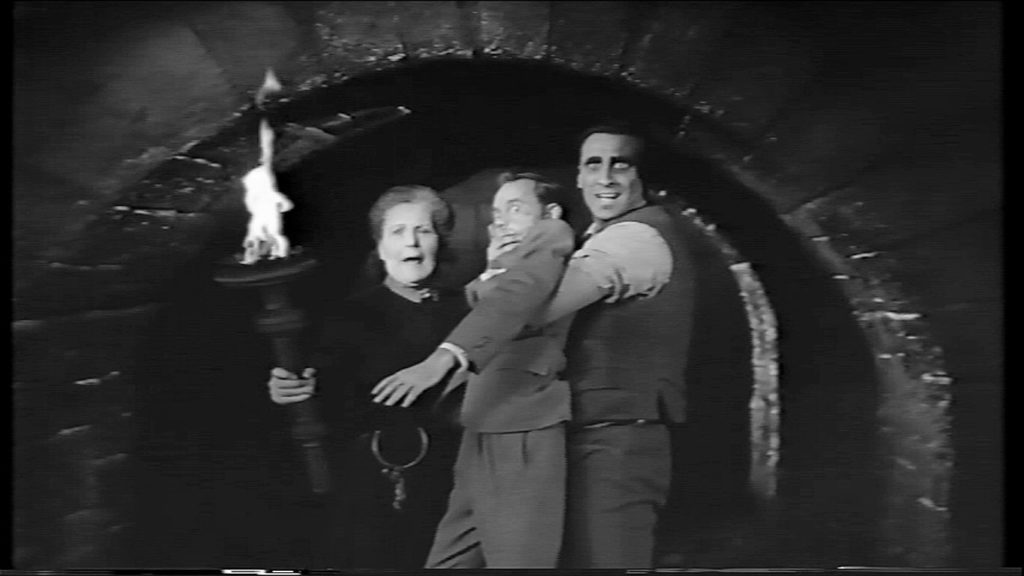
Which bring us to the highly anomalous Francis in the Haunted House (1956). Directed by Charles Lamont instead of Lubin and starring a rapidly aging Mickey Rooney instead of O’Conner (Rooney, coincidentally, was Lubin’s first choice over O’Conner for the first Francis film), the movie is nothing short of a sea change for the series. Unfortunately, the changes wouldn’t take, and this tonal reboot proved to be the last stop before ol’ Francis was finally put out to pasture. Shirking wartime bonding in favor of a horror-comedy/“wrong man” mash-up, Haunted House is, as one might guess, reminiscent of something like the Bob Hope vehicle The Ghost Breakers, or even (when you figure in the presence of a talking animal and a Gothically-vibed mystery) a kind of proto-Scooby-Doo. It’s all a lot of zany fun, with Rooney playing reporter David Prescott- a different, and far dumber acquaintance of Francis’.
When the mule witnesses a murder, he turns to Prescott to go to get the truth out there. Unfortunately, the police mistake his intricate knowledge of the crime for a confession. And the excuse that “A talking mule told me!” only makes things worse for him. Meanwhile, Francis can’t pull his normal stunt of wandering in chatting at the last minute to save the day since he’s come down with laryngitis.
But don’t worry, the series’ central novelty isn’t hushed for too long. Animation voice legend Paul Frees has stepped into Chill Wills’ horseshoes to satisfying effect, perhaps doing even more talking than the mule does in the average previous Francis pictures. With the stakes heightened to life-or-death status with a side order of haunted house terror, Francis is extra terse in this movie. He’s always the smartest mule in the room, but in this one, he’s practically a genius and a championship scholar.
Haunted House though, in retrospect, seems as though it was never destined to fully work out. When any given previous Francis film works, it’s because the notion of a talking mule is comparatively absurd in the face of whatever real-world/mundane situation he finds himself in. (The Army, a newspaper city room, a farm, the Navy, etc.). It might’ve seemed like a no-brainer to plop Francis the talking mule into a cobwebbed supernatural premise, but even as both notions were long in the tooth by 1956, the clash of too much non-reality with Lubin’s well-established confines takes its toll to some degree.
*****

If you thought that the mule talked a lot, just wait until you enter Kino’s Land of Too Many Commentaries!!! That’s a joke, of course… Good commentaries are always welcome, even when there is a daunting amount of them to consider in a short period of time. Other than some assorted Francis movie trailers, these are it in terms of bonus features on this set. The seven commentaries, one for each film, are profiled in order, below:
Australian author/film historian Lee Gambin kicks off this impressive cattle drive of commentators with a solidly dense track over the initial Francis film. Gambin, an avowed animal lover and lifelong Francis fan, is nothing if not enthusiastic in his observations and retellings. He zigs and zags all over, rarely stopping for breath, but the information is terrific even as his readings on the film’s themes (he sees statements on post-traumatic stress disorder and animal rights) sometimes stretches how most viewers are likely to process the film. He’s probably not wrong, though (particularly about the PTSD angle), and he’s spot-on when he discusses the Francis series as “comfort films”. On the whole, Gambin’s track lands as an accomplished diatribe on how such “comfort films” can still have an awful lot to say- even if it’s from the mouth of a mule!
Film historian Eddy Von Mueller takes the commentary reins for the second film, the much-anticipated Francis Goes to the Races. Compared to Gambin, Von Mueller’s staccato delivery feels almost like downshifting to half-speed. Per his own commentary style, he tends to veer down his own mental rabbit holes for minutes on end (for example, listing prominent “man child” movies through film history as he makes the argument that O’Conner’s Pete belongs among them). Therefore, it’s all the more surprising when, from out of left field, he tends to just drop brilliant observations.
The track for Francis Goes to West Point by film historian Toby Roan is a passable Wikipedia-esque affair. Roan is plenty listenable, but deep-level research seems scarce here, and the frequent gaps of his silence are long enough to lure one back to watching the movie proper. When he finally pipes up again, it’s mildly jarring.
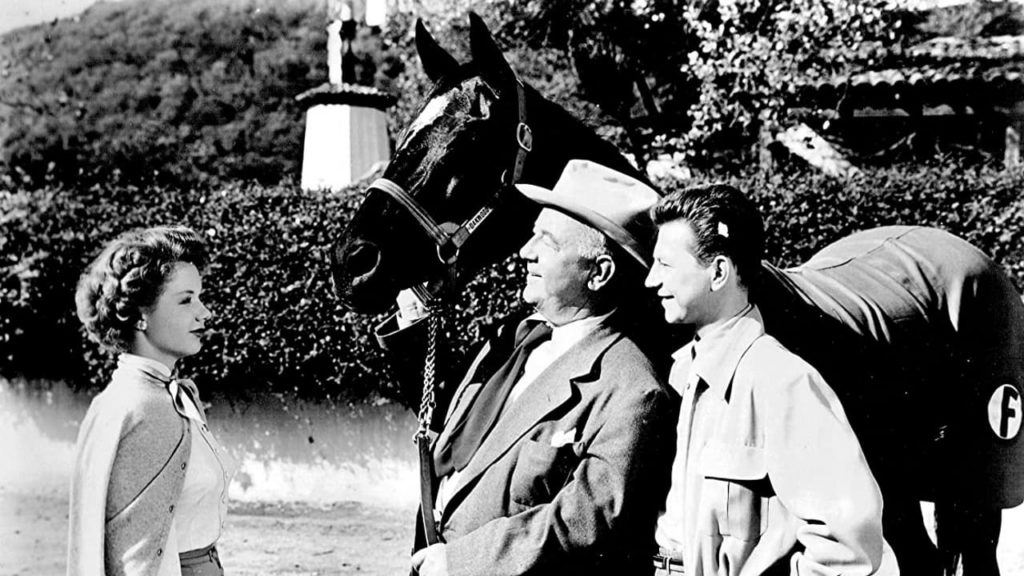
Australian film historian Stephen Vagg is on hand to discuss Francis Covers the Big Town, and he’s not slowing down! Vagg is intent on covering as much ground as he can with the time he’s been given, which is the film’s running time of just under ninety minutes. He’s personable, and he’s definitely done his homework, but he also bounces around from topic to topic a bit too much. Hopefully he can streamline his focus and pace for future efforts.
Next, it’s time to ramp the energy up once more for the set’s first shared commentary. Seeing how Francis Joins the WACS is the closest that the series gets to a bona fide sequel to the first film, it’s fitting that that film’s commentator, Lee Gambin, returns for this one. And since sequels always must add something, Gambin brings in fellow film journalist/author Staci Layne Wilson with whom to discuss this superior Francis film. Like the movie, it’s a fun one- particularly when Wilson recalls the working relationship her mother, Buni Bacon, had with WACS costar Mamie Van Doren in later sexploitation pictures.
Gambin returns one final time to discuss the sixth of these seven films, Francis in the Navy. With him this time is film historian Paul Anthony Nelson. Gambin, having already rolled out a lot of his Francis observations in his previous two tracks on this set, essentially hosts Nelson as the two casually discuss in the Navy, focusing heavily on the surprisingly extensive relationship between director Lubin and co-star Clint Eastwood. (Lubin basically gave Eastwood his start). Good thing Eastwood was in this movie, otherwise who knows what would be left to comment on at this point.
Actually, there’s quite a bit left to say. In his commentary (his second on this set) for Francis in the Haunted House, Eddy Von Mueller goes into terrific detail on the state of Universal International itself circa 1956. In and around that narrative, he provides the requisite info on the film’s actors and whatnot. Even with Von Mueller’s half-distracted delivery style, it’s a great way to put this set to bed.
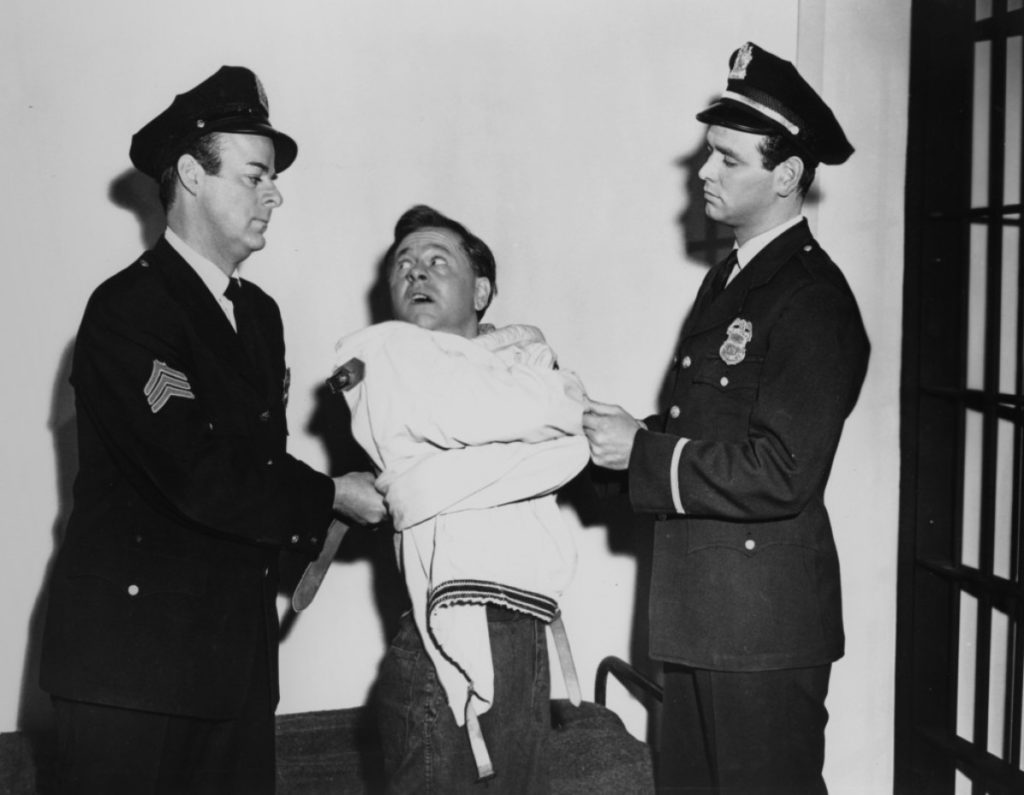
*****
As monorail huckster Lyle Lanley once stated in a classic episode of The Simpsons, “[It’s] a little like the mule with a spinning wheel. No one knows how he got it and dang if he knows how to use it.” Any mule except Francis, that is. If only one thing is apparent from watching all seven of these movies in short order, it’s that Francis is a man among mules even as he’s a talking mule among men. In other words, this old beast of burden is not only far smarter than the average mule, but he’s also head over hooves smarter than most anyone. We could all stand to learn a thing or two from his collected misadventures.
As Lee Gambin happily points out, these are, first and foremost, “comfort movies”. But for those of us who take comfort in our armchair sociological contextualizing, what a feedbag of mid-century content we have here! Not only are the Francis films great for throwback-y afternoon entertainment, they’re also a valid window into what mainstream attitudes towards, among other things, WWII, servicemen (and servicewomen), crime, decorum, gender relations, animal relations, and mental health looked like in 1950s America. To back this up, here’s a recent Facebook post from ZekeFilm’s own Justin Mory, who also watched each of these films on his own prior to this set being announced:

Francis may have no use for a spinning wheel, but the rest of us can get plenty of use from spinning these fine, fun “comfort films” from KL Studio Classics.

